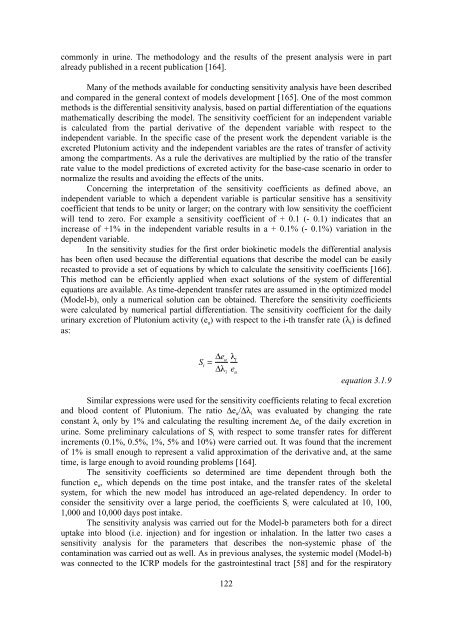Plutonium Biokinetics in Human Body A. Luciani - Kit-Bibliothek - FZK
Plutonium Biokinetics in Human Body A. Luciani - Kit-Bibliothek - FZK
Plutonium Biokinetics in Human Body A. Luciani - Kit-Bibliothek - FZK
You also want an ePaper? Increase the reach of your titles
YUMPU automatically turns print PDFs into web optimized ePapers that Google loves.
commonly <strong>in</strong> ur<strong>in</strong>e. The methodology and the results of the present analysis were <strong>in</strong> part<br />
already published <strong>in</strong> a recent publication [164].<br />
Many of the methods available for conduct<strong>in</strong>g sensitivity analysis have been described<br />
and compared <strong>in</strong> the general context of models development [165]. One of the most common<br />
methods is the differential sensitivity analysis, based on partial differentiation of the equations<br />
mathematically describ<strong>in</strong>g the model. The sensitivity coefficient for an <strong>in</strong>dependent variable<br />
is calculated from the partial derivative of the dependent variable with respect to the<br />
<strong>in</strong>dependent variable. In the specific case of the present work the dependent variable is the<br />
excreted <strong>Plutonium</strong> activity and the <strong>in</strong>dependent variables are the rates of transfer of activity<br />
among the compartments. As a rule the derivatives are multiplied by the ratio of the transfer<br />
rate value to the model predictions of excreted activity for the base-case scenario <strong>in</strong> order to<br />
normalize the results and avoid<strong>in</strong>g the effects of the units.<br />
Concern<strong>in</strong>g the <strong>in</strong>terpretation of the sensitivity coefficients as def<strong>in</strong>ed above, an<br />
<strong>in</strong>dependent variable to which a dependent variable is particular sensitive has a sensitivity<br />
coefficient that tends to be unity or larger; on the contrary with low sensitivity the coefficient<br />
will tend to zero. For example a sensitivity coefficient of + 0.1 (- 0.1) <strong>in</strong>dicates that an<br />
<strong>in</strong>crease of +1% <strong>in</strong> the <strong>in</strong>dependent variable results <strong>in</strong> a + 0.1% (- 0.1%) variation <strong>in</strong> the<br />
dependent variable.<br />
In the sensitivity studies for the first order biok<strong>in</strong>etic models the differential analysis<br />
has been often used because the differential equations that describe the model can be easily<br />
recasted to provide a set of equations by which to calculate the sensitivity coefficients [166].<br />
This method can be efficiently applied when exact solutions of the system of differential<br />
equations are available. As time-dependent transfer rates are assumed <strong>in</strong> the optimized model<br />
(Model-b), only a numerical solution can be obta<strong>in</strong>ed. Therefore the sensitivity coefficients<br />
were calculated by numerical partial differentiation. The sensitivity coefficient for the daily<br />
ur<strong>in</strong>ary excretion of <strong>Plutonium</strong> activity (e u) with respect to the i-th transfer rate (λ i) is def<strong>in</strong>ed<br />
as:<br />
S i = Δe u<br />
Δ i<br />
122<br />
equation 3.1.9<br />
Similar expressions were used for the sensitivity coefficients relat<strong>in</strong>g to fecal excretion<br />
and blood content of <strong>Plutonium</strong>. The ratio Δe u/Δλ i was evaluated by chang<strong>in</strong>g the rate<br />
constant λ i only by 1% and calculat<strong>in</strong>g the result<strong>in</strong>g <strong>in</strong>crement Δe u of the daily excretion <strong>in</strong><br />
ur<strong>in</strong>e. Some prelim<strong>in</strong>ary calculations of S i with respect to some transfer rates for different<br />
<strong>in</strong>crements (0.1%, 0.5%, 1%, 5% and 10%) were carried out. It was found that the <strong>in</strong>crement<br />
of 1% is small enough to represent a valid approximation of the derivative and, at the same<br />
time, is large enough to avoid round<strong>in</strong>g problems [164].<br />
The sensitivity coefficients so determ<strong>in</strong>ed are time dependent through both the<br />
function e u, which depends on the time post <strong>in</strong>take, and the transfer rates of the skeletal<br />
system, for which the new model has <strong>in</strong>troduced an age-related dependency. In order to<br />
consider the sensitivity over a large period, the coefficients S i were calculated at 10, 100,<br />
1,000 and 10,000 days post <strong>in</strong>take.<br />
The sensitivity analysis was carried out for the Model-b parameters both for a direct<br />
uptake <strong>in</strong>to blood (i.e. <strong>in</strong>jection) and for <strong>in</strong>gestion or <strong>in</strong>halation. In the latter two cases a<br />
sensitivity analysis for the parameters that describes the non-systemic phase of the<br />
contam<strong>in</strong>ation was carried out as well. As <strong>in</strong> previous analyses, the systemic model (Model-b)<br />
was connected to the ICRP models for the gastro<strong>in</strong>test<strong>in</strong>al tract [58] and for the respiratory<br />
i<br />
e u












![{A1[]Sp - Bibliothek](https://img.yumpu.com/21908054/1/184x260/a1sp-bibliothek.jpg?quality=85)




